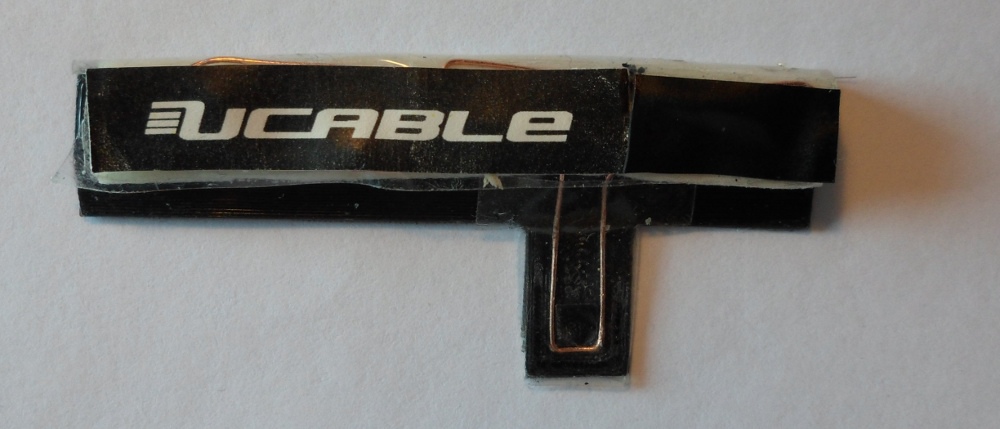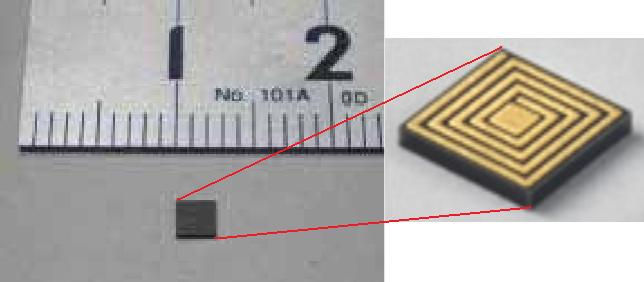Russian RFID sensor for data center
Hello honorable ladies and gentlemen. The other day I managed to make a prototype of the RFID sensor for the data center on a passive RFID tag of the EPC Gen2 standard.

It does not look very aesthetic yet, but it is cheap, reliable and practical. The principle of operation and the design of the sensor below.
The length of the sensor is 1U (or 1 version = 4.45 cm). The 3D printer is printed with a 0.5 mm base RFID tag. The lower appendix contains a groove for accommodating copper wire and a groove for the Hitachi Ultra Small Package RFID tag. The photo of the tag below is increased, since the size of this tag is 2.5x2.5x0.4 mm

The copper wire laid in the groove provides the inductive coupling of the Hitachi tag with the RFID antenna reduced dipole located at the top of the sensor. Since the RFID sensor is designed to work on metal, the dipole is raised using foam tape to a height of 5mm. That is, the “appendix” has a thickness of 0.5 mm, and the rest of the sensor is 5.5 mm.
')
The sensor can be placed on the rail of the telecommunications rack.

The black cable on the left is an emitting coaxial cable connected to the UHF RFID reader. This reads the RFID identifier of the sensor associated with the specific rack unit number.
Equipment can be installed in the rack unit.

The "appendix" is closed by the "ear" of the equipment, and the RSSI of the RFID sensor changes immediately. At this moment, the reason is shown that the thickness of the "appendix" is 0.5 mm. The springing protruding holders of square nuts also have a thickness of 0.5 mm, and they will not allow to crush the appendix. Thus, it is possible to automatically track in real time the fact of equipment placement in the rack. In the photo there is another RFID tag OmniID, located on the patch panel. Its identifier is related to specific equipment. Thus, it is possible to determine not only where the equipment is installed, but also what equipment is installed in this unit.
In order to bring the “iron” to serial production, you only need to make an RFID sensor in the form of a printed circuit board, or rather two printed circuit boards: one 0.5 mm thick and the other 5 mm thick with metal butt half holes for overlapping with the first printed circuit board. Or else you can make a suitable RFID inlay to stick on a plastic substrate of variable height. But inlay must be negotiated with the Chinese.
An important advantage of the RFID sensor is that it can easily be installed in existing working data centers with integration with any DCIM (Data center infrastructure management). At the time of installation of the RFID system, each piece of equipment in the data center is equipped with a standard serial RFID tag (for example, the same OmniID), each rack is equipped with an RFID antenna. An audit is being conducted, and the current placement of equipment in the data center is recorded in DCIM. Using serial RFID tags and RFID antennas, you can track attempts to move equipment. And RFID sensors can be installed gradually, in the process of moving equipment, when a unit in the racks is released.

It does not look very aesthetic yet, but it is cheap, reliable and practical. The principle of operation and the design of the sensor below.
The length of the sensor is 1U (or 1 version = 4.45 cm). The 3D printer is printed with a 0.5 mm base RFID tag. The lower appendix contains a groove for accommodating copper wire and a groove for the Hitachi Ultra Small Package RFID tag. The photo of the tag below is increased, since the size of this tag is 2.5x2.5x0.4 mm

The copper wire laid in the groove provides the inductive coupling of the Hitachi tag with the RFID antenna reduced dipole located at the top of the sensor. Since the RFID sensor is designed to work on metal, the dipole is raised using foam tape to a height of 5mm. That is, the “appendix” has a thickness of 0.5 mm, and the rest of the sensor is 5.5 mm.
')
The sensor can be placed on the rail of the telecommunications rack.

The black cable on the left is an emitting coaxial cable connected to the UHF RFID reader. This reads the RFID identifier of the sensor associated with the specific rack unit number.
Equipment can be installed in the rack unit.

The "appendix" is closed by the "ear" of the equipment, and the RSSI of the RFID sensor changes immediately. At this moment, the reason is shown that the thickness of the "appendix" is 0.5 mm. The springing protruding holders of square nuts also have a thickness of 0.5 mm, and they will not allow to crush the appendix. Thus, it is possible to automatically track in real time the fact of equipment placement in the rack. In the photo there is another RFID tag OmniID, located on the patch panel. Its identifier is related to specific equipment. Thus, it is possible to determine not only where the equipment is installed, but also what equipment is installed in this unit.
In order to bring the “iron” to serial production, you only need to make an RFID sensor in the form of a printed circuit board, or rather two printed circuit boards: one 0.5 mm thick and the other 5 mm thick with metal butt half holes for overlapping with the first printed circuit board. Or else you can make a suitable RFID inlay to stick on a plastic substrate of variable height. But inlay must be negotiated with the Chinese.
An important advantage of the RFID sensor is that it can easily be installed in existing working data centers with integration with any DCIM (Data center infrastructure management). At the time of installation of the RFID system, each piece of equipment in the data center is equipped with a standard serial RFID tag (for example, the same OmniID), each rack is equipped with an RFID antenna. An audit is being conducted, and the current placement of equipment in the data center is recorded in DCIM. Using serial RFID tags and RFID antennas, you can track attempts to move equipment. And RFID sensors can be installed gradually, in the process of moving equipment, when a unit in the racks is released.
Source: https://habr.com/ru/post/220499/
All Articles